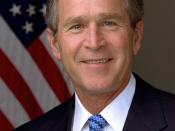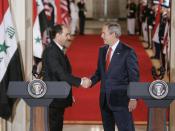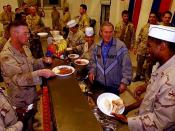Example 1: President Bush Acting as Chief-of-State
As Chief-of-State, the President of the United States is an aspiring example for the American people. Unlike other countries such as England--which have honored, respected leaders (ex: the Queen of England) who celebrate national holidays/stand for country ideals--the United States has no such leader solely for this task. Instead, the President takes up the task of Chief-of-State by making patriotic speeches, congratulating award winners, rewarding NASA astronauts, etc. On March 14, 2006, President Bush, on his way to New York to speak on medicare, stopped at a nearby airport to meet and greet Jason McElwain. McElwain, an autistic teenager, recently inspired the country by scoring 20 points in four minutes in a varsity high school basketball game. Essentially, President Bush met with this inspiring high school basketball player and his parents to congratulate them. We see President Bush as Chief-of-State, engaging in a ceremony that can improve his image to the public.
Example 2: President Bush as Chief Legislator
Under the U.S. Constitution, only Congress is actually given the power to make laws. However, the Constitution gives the president power to influence Congressional lawmaking. Presidents can be a major force in legislative activity, by signing or vetoing bills, by making a persuasive speech to Congress, etc. On March 20, 2006, President Bush signed a bill raising the national debt ceiling to $8.96 trillion--almost $9 trillion. This will allow the United States to further finance the war in Iraq without increasing taxes. This debt increase is the fourth since President Bush came to power, and the budget deficit is at an all-time high. In this case, Bush probably persuaded Congress to pass this debt-limit-increase bill and, once they did, he signed the bill; in doing so Bush acted as Chief Legislator.


